Home Decor Styles
Below is a comprehensive list of major home decor styles, from historical classics to current and emerging trends. Each style includes a brief description and notable elements that define the look. Use this guide to get familiar with the characteristics of each style – it can help you refine your tastes or mix and match styles confidently in your home.
Using the Guide: As you explore these styles, remember that you don’t have to stick to just one. Many beautiful homes mix elements from different styles to create a look that’s uniquely personal. Feel free to use this guide as a starting point – maybe you love the colors of Coastal style, the furniture shapes of Mid-Century Modern, and the textures of Boho; you can blend aspects you like from each. Interior design is most successful when it reflects you, so use the quiz results and style descriptions to inspire your own twist on your ideal home decor style. Happy decorating!
Art Deco Style
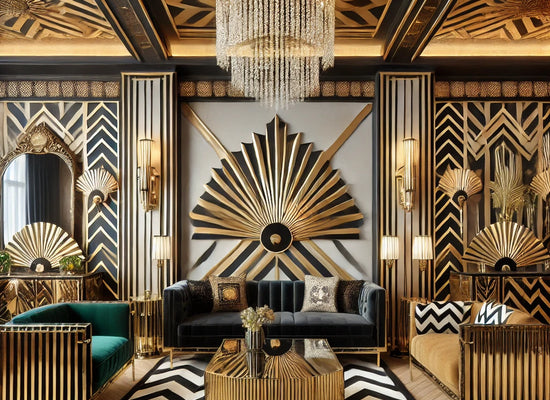
Description: Art Deco is a glamorous, geometric style that emerged in the 1920s and 1930s. It embodies the Roaring Twenties’ spirit of luxury and progress. In an Art Deco interior, expect a sense of drama and opulence conveyed through bold lines and geometric patterns. The style often features a mix of modern and handcrafted artistry – it was modern for its time, with an emphasis on symmetry and streamlined forms, but also lavish in materials and details. Art Deco rooms feel like a step into a vintage movie scene or a grand hotel lobby from that era.
Notable Elements: Geometric motifs everywhere – zigzags, chevrons, sunburst patterns, and stepped designs (like the Chrysler building silhouette echoed in furniture shapes or mirrors). Materials are luxurious: mirrors and glass, polished wood veneer, marble, and metals like brass or chrome. You might see mirrored furniture or decor, velvet upholstered chairs, and black-and-gold or black-and-white color schemes for stark contrast. Jewel tones (emerald, sapphire, ruby) also appear as accents. Lighting often makes a statement, with sconces or lamps in stylized shapes (think fan-shaped glass shades or chandeliers with cascading crystals). Art Deco is all about glamour and Jazz Age elegance.
Biophilic Design Style
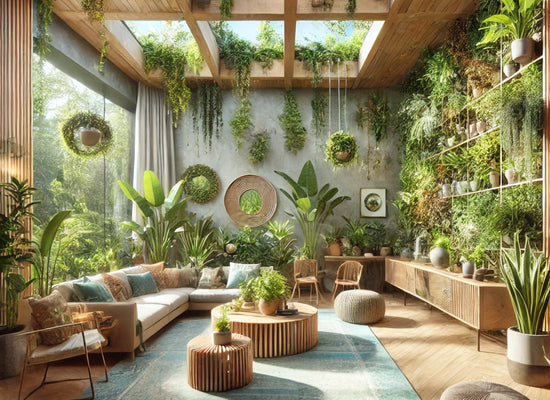
Description: Biophilic design isn’t just a style; it’s an approach that integrates nature and natural processes into interior design. The idea is to improve wellbeing by creating a stronger connection between people and nature in their homes. Spaces designed with a biophilic mindset feel refreshing and alive. While you can apply biophilic principles to any aesthetic, as a standalone style it often results in rooms that are green, airy, and calming, almost like an indoor garden.
Notable Elements: Lots of plants, and we mean lots – everything from potted plants and hanging gardens to living walls (vertical plant installations) could be present. Natural light is maximized; big windows, skylights, and glass doors help blend indoors with outdoors. Materials are natural and sustainable: think reclaimed wood, bamboo, natural stone, cork, and organic fabrics. Water features (like a small indoor fountain) or nature-inspired patterns (leaf motifs, floral prints) might be incorporated. Colors are typically those found in nature: various greens, earthy browns, sky blues. The key is an environment that fosters a sense of tranquility and connection to nature, making you feel healthier and more at ease at home.
Bohemian (Boho) Style
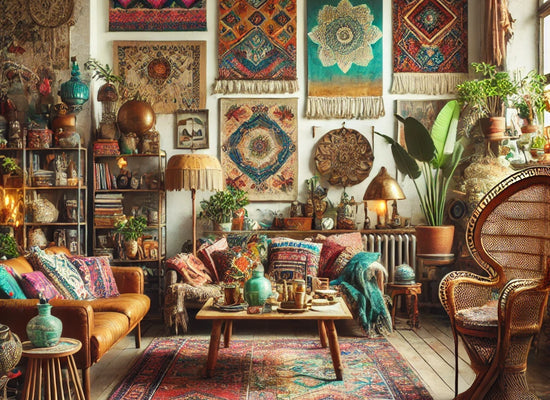
Description: Bohemian style is a free-spirited mix of global influences, artistic collections, and laid-back comfort. Boho interiors break rules in the best way, layering different colors and patterns and mixing old with new. The atmosphere is often warm, welcoming, and a bit whimsical – the kind of space filled with life and personality. Every corner might showcase something interesting, from a gallery wall of art and photos to shelves crammed with books and travel treasures.
Notable Elements: Rich, vibrant colors or alternately, a base of earthy tones with pops of jewel tones (turquoise, magenta, amber). Patterned rugs, ethnic textiles (like kilims, suzanis, or batik fabrics), macramé wall hangings, and plenty of pillows create a cozy vibe. Furniture is usually an eclectic mix – you might have a mid-century chair next to a painted Indian coffee table and a rattan peacock chair. Lots of plants (the more the better) bring nature inside. Overall, boho style feels collected and eclectic, often with a vintage or handmade quality to many pieces.
Coastal Style
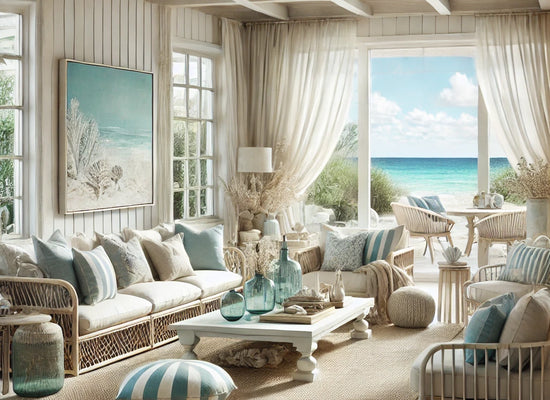
Description: Coastal style captures the easy-breezy feeling of a beach vacation home. It’s all about light, airiness, and a connection to the sea (or any body of water). Coastal interiors often use a palette of whites and neutrals with accents of blue or turquoise, reminiscent of sand and ocean waves. The vibe is casual and calming, making you feel like you can kick off your shoes and relax. This style ranges from nautical New England cottage to tropical island retreat, but the common thread is that laid-back, summery ambiance.
Notable Elements: Natural light is maximized – sheer curtains or no curtains at all. Materials like rattan, jute, sisal, and driftwood bring in a beachy texture. You’ll often find striped patterns (nautical stripes), shell or coral motifs, and ocean-themed artwork or accessories (like glass vases that mimic sea glass, or maps of the coast). White furniture or weathered wood finishes keep the look light. In a coastal home, there’s usually an emphasis on indoor-outdoor living – for example, patios or sunrooms are decorated as extensions of the interior. The overall feel is fresh, relaxed, and inspired by the seaside.
Contemporary Style
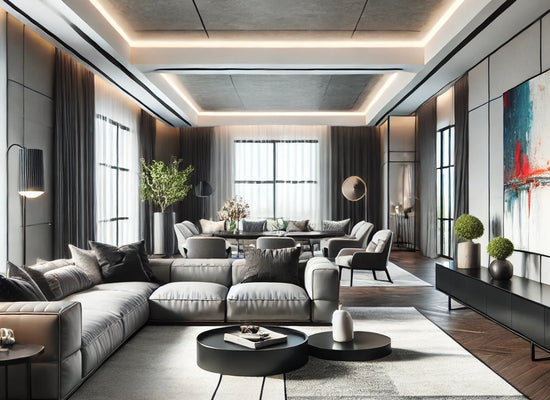
Description: Contemporary design refers to the current, up-to-date style of the moment. It is ever-evolving, often borrowing elements from modern, minimalist, and even traditional styles to create a balanced, stylish look. Contemporary interiors typically feature clean lines, smooth surfaces, and a mix of neutral tones with deliberate pops of color to avoid feeling stark. Furniture tends to be comfortable yet streamlined – think of a simple sofa with plush upholstery, paired with a bold abstract painting on the wall.
Notable Elements: Neutral color palettes (grays, whites, blacks) with accent colors, open spaces with lots of light, mix of textures (like a sleek leather couch with a soft textured rug), and modern artwork or accessories. Unlike strictly minimalist design, contemporary style often includes a few on-trend pieces and can be more fluid, changing as new trends emerge.
Cottagecore Style
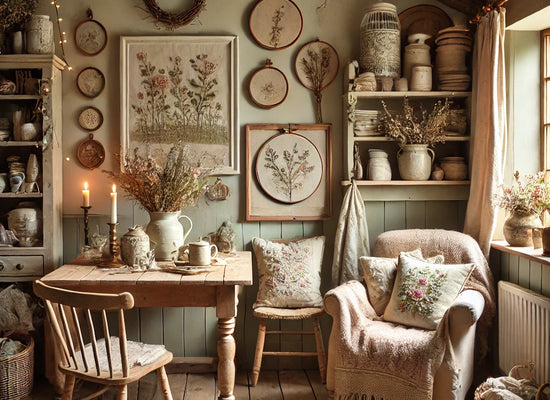
Description: Cottagecore is more than just a decor style – it's an aesthetic movement romanticizing rural and cottage life. In interior design, cottagecore translates to cozy, quaint spaces that feel like a storybook cottage in the woods. It emphasizes simplicity, craftsmanship, and a touch of fantasy, as if you might be living in a cozy fairy-tale cottage or an English countryside home. The mood is nostalgic, warm, and invitingly cluttered with meaningful items.
Notable Elements: Floral patterns, botanical motifs, and soft colors (sage greens, dusty pinks, warm creams) abound. Vintage furniture (worn wooden tables, upholstered armchairs) and handmade or DIY decor (embroidered hoops, homemade quilts) are key. You’ll often find open shelving displaying mix-and-match ceramics, mason jars used for storage, and lots of houseplants or dried flowers. Natural materials like wood, stone, and wicker add to the rustic charm. A touch of whimsy is welcome – think antique lace tablecloths, fairy lights or candles, and cozy reading nooks with stacks of old books. Every corner of a cottagecore home invites you to slow down and enjoy simple pleasures.
Eclectic Style
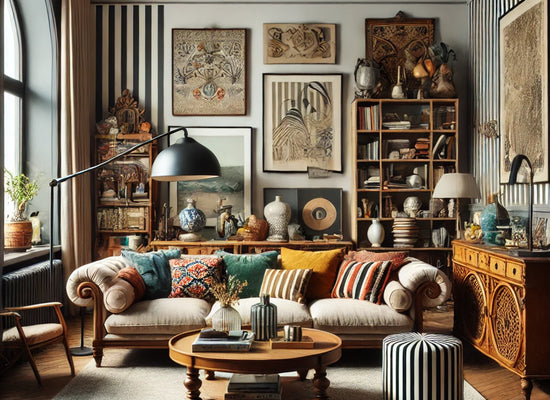
Description: Eclectic style is all about mixing and matching to create a custom look that defies any one label. It’s similar to bohemian in its blend of different styles, but it doesn’t always have the same global or boho flair – it’s more about curating varied pieces that you simply love. An eclectic living room might combine modern art with a Victorian-style sofa and an industrial coffee table, for example. The key to eclectic design is balance and editing: even though you’re pulling from many sources, you ensure the composition feels intentional.
Notable Elements: A variety of colors and textures, though often balanced with a neutral backdrop to ground the mix. Statement pieces from different eras – maybe a sleek lamp on a carved wood sideboard. Use of collected items, art, and accessories that reflect different interests or travels. Patterns can be mixed (stripes with florals, etc.), but often there’s a unifying element like a consistent color tone that ties things together. Eclectic style embraces creativity and personal expression, resulting in a one-of-a-kind space.
Farmhouse Style (Including Modern Farmhouse)
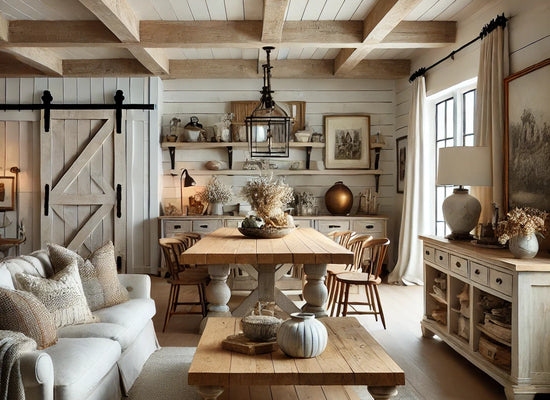
Description: Farmhouse style is inspired by the simple, cozy charm of rural farmhouses. It has become hugely popular (especially in its modern updated form) for its warmth and unpretentiousness. Farmhouse interiors prioritize comfort and practicality, often using honest, sturdy materials and a lived-in look. Modern Farmhouse, popularized by designers like Joanna Gaines, takes that rustic foundation and adds cleaner lines or industrial touches to fit today’s homes.
Notable Elements: Natural wood and white is a classic farmhouse combo – e.g., a big farmhouse dining table with a white painted base and a natural wood top, or shiplap wood paneling on walls painted white. You’ll find slipcovered sofas, apron-front sinks, barn doors, and vintage-inspired accessories. Colors are typically light and neutral (warm whites, soft grays) with accents in black or gentle pastels. Distressed or reclaimed finishes give furniture a well-worn, hand-me-down character. In modern farmhouse, you might also see industrial lighting or metal accents (like black iron shelf brackets) for a contemporary twist.
French Country Style
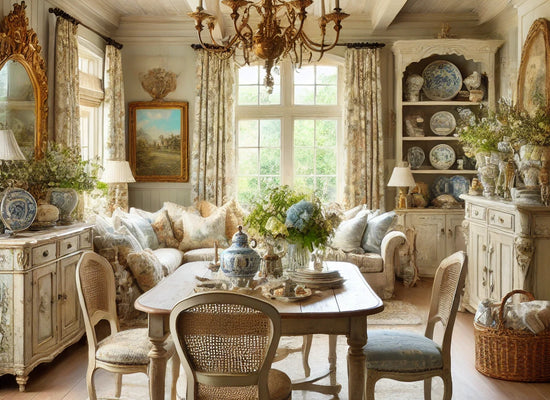
Description: French Country (or French Provincial) style comes from the charming homes of the French countryside. It blends rustic and refined elements, creating an ambiance that’s elegant but not stuffy. Imagine a sunny farmhouse in Provence filled with well-loved furniture and soft colors. French Country decor often features a mix of weathered woods, pretty patterns, and curvy, graceful furniture forms. The overall feeling is welcoming, romantic, and a touch old-world.
Notable Elements: Light to medium wood tones often with a painted or distressed finish (like an ivory painted dresser with a bit of wear). Furniture pieces might include cabriole legs, caned chair backs, and farmhouse tables. Common fabrics are toiles, floral prints, checks, and stripes in muted colors (soft blues, yellows, greens, and creams). You’ll see ceramic dishware displays, wrought iron lighting or accents, and fresh or dried flowers as decor. Decorative trims like ruffles or scallops can appear on pillows or curtains. The key is a balance of elegance (gilded mirrors, chandeliers) with rustic charm (chippy paint, natural linens).
Grandmillennial Style
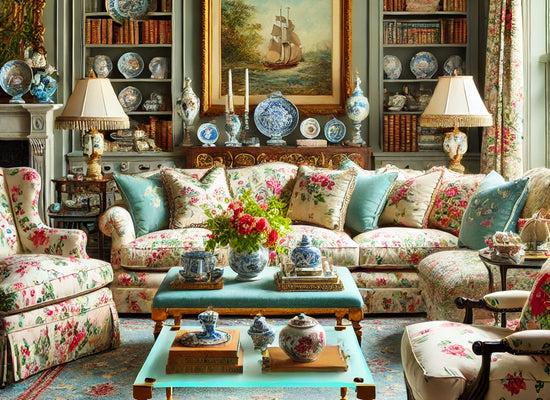
Description: Grandmillennial style is a relatively recent term (a portmanteau of "grandma" and "millennial"). It describes younger generations embracing and refreshing traditional decor elements that might be found in their grandparents’ homes. Think of it as “granny chic.” Rather than mid-century modern or all-white minimalism, grandmillennial decorators love prints, fringe, and vintage flair, but they style these elements in a way that feels current, not stuffy. The result is a charming, layered look that honors the past but has a youthful wink.
Notable Elements: Floral chintz fabrics, needlepoint pillows, skirted tables, and wallpaper are back! You’ll see mix-and-match china, antique brass fixtures, and embroidered linens. Color palettes can be pretty and varied – often incorporating pastels or saturated hues reminiscent of heirloom upholstery. Key to grandmillennial is the mix: for instance, a modern acrylic coffee table might sit atop a Persian-style rug, or a bold contemporary art piece might hang above a traditional camelback sofa in a bright floral fabric. Collections of figurines or classic books, once thought old-fashioned, are displayed with pride. The style is all about coziness and personality, rejecting the notion that traditional equals boring. It proves that old-school decor can be cool and quirky when done with intent.
Hollywood Regency (Glam) Style
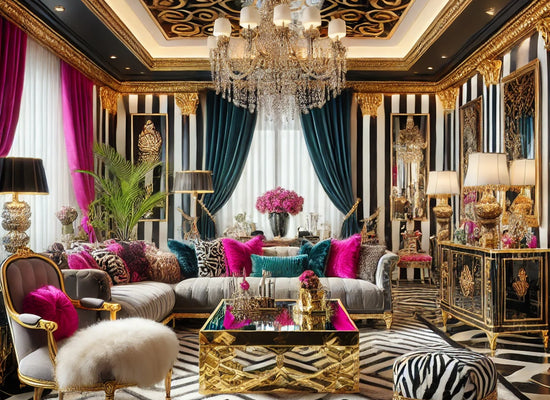
Description: Hollywood Regency (also known as Hollywood Glam) is an interior design style that emerged in the golden age of Hollywood (circa 1930s-1950s). It’s all about glitz, glamour, and a touch of drama, combining classical influences with high-end flair. This style was used to decorate the homes of movie stars and film sets, aiming to exude luxury and make a bold impression. A Hollywood Regency space is opulent and chic, but also playful – it doesn’t shy away from a bit of extravagance or quirky statement pieces.
Notable Elements: Expect luxurious fabrics like velvet, satin, and silk on furniture and curtains. The color palette often uses high contrast (black and white) paired with vibrant hues (hot pink, turquoise, gold) as accents. Mirrored and lacquered finishes on furniture (like a shiny black lacquered console or mirrored coffee table) add sparkle. Gold and brass metallic accents are common – from gilded mirror frames to brass light fixtures. Furniture shapes might borrow from classic designs (Greek key patterns, Chinese Chippendale chairs, French Louis chairs) but are often updated with bold colors or glossy finishes. Animal prints (like zebra or leopard rugs and pillows) and chandelier lighting are also hallmark touches. Overall, Hollywood Regency celebrates a stylish mix of elegance and fun, making a room feel like a glamorous stage.
Industrial Style
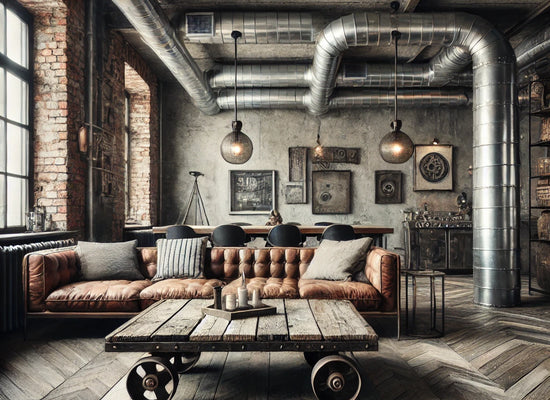
Description: Industrial style draws inspiration from urban lofts and old factories. It celebrates raw and unfinished elements, creating a stylish warehouse-like vibe in a home. In an industrial-style room, you might see exposed brick walls, visible pipes/ductwork, concrete or weathered wood floors, and utilitarian objects turned into decor. The color scheme is often neutral and monochromatic, focusing on textures and materials rather than lots of color.
Notable Elements: Metals and wood are key players – think iron light fixtures, steel frames, reclaimed wooden beams, and rustic wood surfaces. Furniture often has a rugged, repurposed look (for example, a coffee table made from a vintage factory cart). Lighting might include metal pendant lights or Edison bulb fixtures. To soften the look, industrial style can be paired with vintage or even modern pieces, but it always maintains an edgy, no-frills atmosphere.
Japandi Style
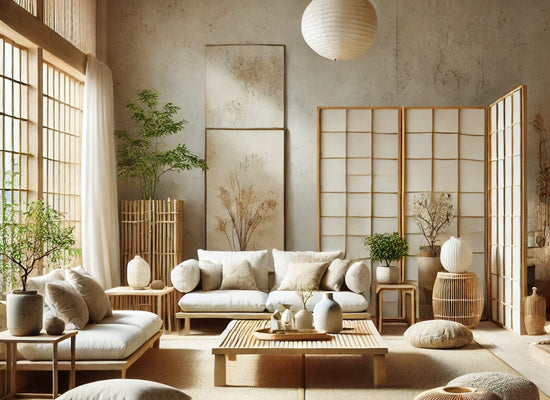
Description: Japandi is a hybrid of Japanese and Scandinavian design, blending the best of both into a minimalist yet warm aesthetic. It combines the Japanese principle of wabi-sabi (finding beauty in imperfection and simplicity) with Scandinavian hygge. A Japandi room feels zen-like and uncluttered, but also cozy and natural. The color palette is neutral and calming – lots of soft whites, beige, and gray, with occasional dark accents or pastels for contrast.
Notable Elements: Natural materials like light woods, bamboo, paper (such as lantern lamps or shoji-style screens) and stone. Low-profile furniture (think floor cushions, low sofas or platform beds) keeps the vibe relaxed. Handmade pottery, simple planters, and minimalist artwork serve as subtle decor. Everything has clean lines but also a crafted, tactile quality. Japandi spaces often feature greenery and emphasize natural light, aiming to create a tranquil, balanced environment.
Maximalist Style
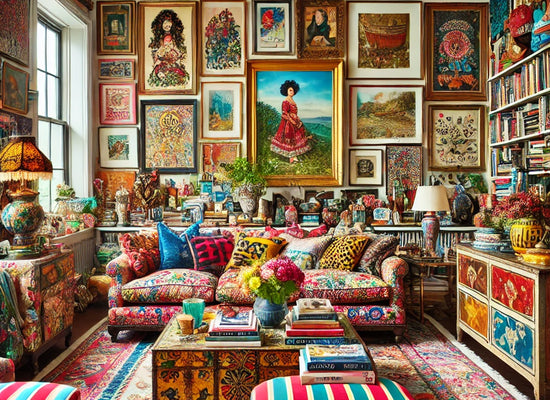
Description: On the opposite end of the spectrum, Maximalist style declares that “more is more!” Maximalist interiors are bold, layered, and full of personality. Rather than focusing on empty space, this style delights in filling rooms with color, pattern, and an array of decor items that reflect various influences. However, a well-done maximalist space is carefully curated – it’s not about random clutter, but about artful combinations that create a lived-in gallery vibe.
Notable Elements: Vibrant color palettes (often with multiple bold colors in one space), mixed patterns (florals, stripes, animal prints – all in one room, why not!), lots of artwork and books on display, and diverse textiles and accessories from different cultures or eras. Gallery walls, layered rugs, and statement furniture (like an embellished sofa or a painted dresser) are common. Maximalism often incorporates sentimental items and collections, making the space feel personal and interesting at every turn.
Mediterranean Style

Description: Mediterranean style encompasses design influences from countries along the Mediterranean Sea, such as Spain, Greece, Italy, and Morocco. It’s a sun-kissed look that often combines casual elegance with rustic touches. Interiors in this style feel inviting and rich in character, often featuring textured walls, exposed beams, and ornate details reminiscent of a villa or adobe. The color schemes tend to reflect the sea and earth: bright whites and blues (Greek Isles), warm terra-cottas and yellows (Tuscan sun), and deep reds and oranges (Moroccan sunsets) depending on the region.
Notable Elements: Stucco or plaster walls, sometimes with a textured or aged finish; patterned ceramic tiles (on floors, backsplashes, or tabletops) featuring geometric or floral Mediterranean motifs. Floors might be stone or clay tile. Arched doorways or windows are common architectural features. Furniture can range from hefty wood pieces with carved details (like Spanish colonial style) to painted and wrought iron pieces. Wrought iron chandeliers, pottery, and lush fabrics (like tapestries or patterned cushions) add to the ambiance. Indoor-outdoor living is key – French doors opening to courtyards, and plenty of plants (from olive trees in pots to lavender and citrus) blurring the line between inside and out.
Mid-Century Modern
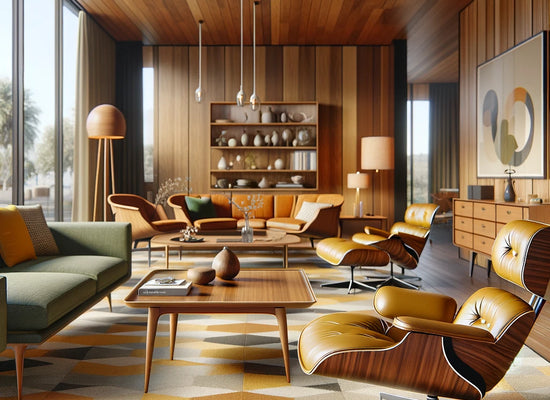
Description: Mid-Century Modern is a timeless style originating from the mid-20th century (roughly the 1940s-1960s). It’s characterized by clean, organic lines, gentle curves, and a functional form-follows-function philosophy. In a Mid-Century Modern room, you might find iconic furniture pieces (like an Eames lounge chair or a sleek kidney-shaped coffee table) that feature tapered legs and simple silhouettes. This style balances form and function, creating an uncluttered but inviting feel that still looks retro-cool today.
Notable Elements: Warm wood tones (teak, walnut) often paired with pops of color like mustard yellow, olive green, or orange; geometric and abstract patterns; furniture with hairpin or peg legs; and integration of new materials for the time (molded plastic, bent plywood, metal). Large windows and open-concept layouts also complement the mid-century vibe, emphasizing indoor-outdoor integration and simplicity.
Minimalist Style

Description: The Minimalist style embraces the principle of “less is more.” Influenced by modern and Scandinavian design, minimalist interiors are pared down to the essentials. Spaces are uncluttered and highly functional, highlighting quality over quantity. A minimalist home might have a very clean color palette (often white, black, and gray) with maybe one accent color or a touch of warmth from natural wood. The idea is to create a sense of calm and focus by eliminating excess ornamentation.
Notable Elements: Streamlined furniture with simple forms, bare walls or very limited art, hidden storage solutions to reduce visible clutter, and plenty of open space. Light is important – both natural light and minimal window treatments to let it in. Every decor piece often has a purpose or sparks joy. Textures can keep the space from feeling too cold (for example, a single piece of artwork or a textured throw on a plain sofa provides visual interest without clutter).
Modern Organic Style
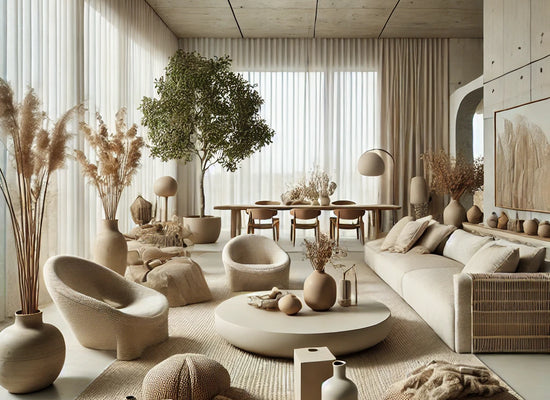
Description: Modern Organic design is a harmonious blend of sleek modern aesthetics and natural, organic elements. It takes the clean lines and minimalism of Modern design but softens it with earthy textures, organic shapes, and warm, nature-inspired materials. The result is a home that feels both contemporary and inviting, with a connection to nature that promotes relaxation and well-being. This style embraces simplicity and function, much like Modern or Scandinavian design, but with a greater emphasis on warmth and natural elements. Spaces feel light, airy, and uncluttered, yet they remain cozy and grounded through the use of soft textiles, wood grains, and organic materials. The Modern Organic aesthetic is perfect for those who appreciate minimalist principles but want a home that feels more welcoming and livable rather than stark and cold.
Notable Elements: Modern Organic spaces typically feature a neutral and earthy color palette, including warm whites, beiges, taupes, soft grays, and muted greens. Walls are often painted in light, soothing tones, allowing natural materials like wood, stone, and linen to take center stage. Furniture retains modern clean lines but incorporates curved edges and organic shapes, creating a sense of flow and softness. Instead of sharp geometric angles, expect rounded coffee tables, sculptural chairs, and plush sofas that invite relaxation. Textures play a crucial role, with woven fabrics, raw linen, wool, and jute adding depth and warmth. Handmade or imperfectly finished pieces, such as pottery, clay vases, and reclaimed wood tables, contribute to the organic feel. Natural light is maximized with sheer, airy curtains or no window treatments at all, creating a bright and uplifting environment. Indoor plants, from large leafy trees to delicate dried arrangements, bring a touch of nature indoors, reinforcing the connection between the home and the outside world. The Modern Organic style is perfect for those who love the sleekness of modern design but crave warmth, comfort, and a deeper connection to nature. It is both refined and effortless, offering a balanced and serene home that feels contemporary yet timeless.
Modern Style
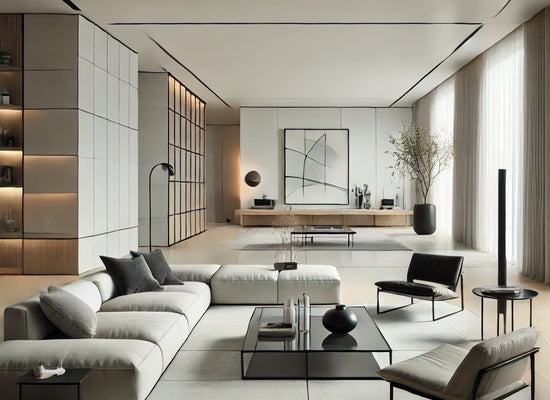
Description: Modern design is a defined aesthetic that emerged in the early-to-mid 20th century, emphasizing simplicity, functionality, and clean lines. Often mistaken for Contemporary design, Modern style follows minimal ornamentation, an open floor plan, and an emphasis on natural materials. The concept of form follows function is key—every piece should be both aesthetically pleasing and practical. Modern interiors feel sleek, airy, and uncluttered, often incorporating elements from Mid-Century Modern but in a more refined and updated way. It balances warmth and sophistication without excess decoration.
Notable Elements: Modern interiors typically feature a neutral color palette, with whites, grays, beiges, and black accents. Spaces are designed to be open and filled with natural light, minimizing partitions to create an airy feel. Furniture is sleek and low-profile, with simple geometric shapes that enhance the streamlined aesthetic. Materials such as wood, leather, glass, stone, and polished concrete are commonly used, reinforcing the focus on natural elements. Decor is kept to a minimum, with statement pieces like abstract art or sculptural lighting taking center stage. Built-in storage solutions maintain a clutter-free look, seamlessly integrating function into the space. Technology is often incorporated, with smart home features, hidden speakers, and automated lighting blending effortlessly into the design. Modern style is ideal for those who appreciate aesthetic simplicity, high-quality materials, and a timeless, functional design. It prioritizes clean spaces, intentional furnishings, and a balance between warmth and sleekness for a home that feels both sophisticated and comfortable.
Rustic Style

Description: Rustic style embraces the beauty of the natural, aged, and hand-crafted. It overlaps with farmhouse but can also lean more cabin-like or lodge-inspired. The goal is to create a warm, earthy environment that feels connected to the countryside or mountains. Rustic interiors often showcase rough textures and unrefined elements – basically, bringing the outdoors in. It’s casual and inviting, the sort of style that makes you want to curl up by a stone fireplace with a cozy blanket.
Notable Elements: Exposed wooden beams, stone or brick accents, and distressed wood floors or furniture set the tone. The furniture tends to be large, comfortable, and durable – overstuffed couches in leather or heavy woven fabrics, farmhouse tables, and perhaps some log or twig furniture in cabin contexts. The color palette comes from nature: browns, deep reds, forest greens, and other earthy tones. Textiles like fur throws, wool blankets, and burlap or canvas add to the texture. Handcrafted objects, antique farm tools or hunting lodge decor (like lanterns or woven baskets) can serve as accessories to complete the rustic look.
Scandinavian Style
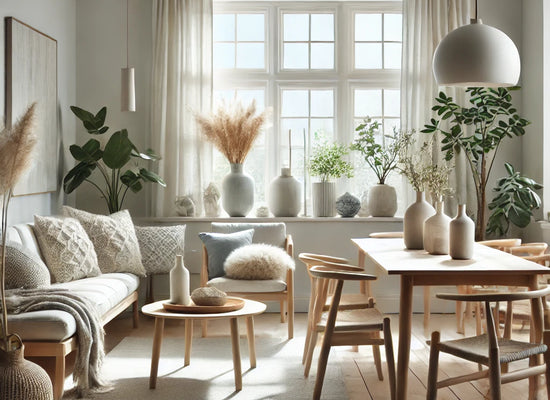
Description: Scandinavian (Nordic) style is all about simplicity, functionality, and coziness. Hailing from the Nordic countries, it emphasizes light and nature to cope with long, dark winters. Interiors are bright and airy, with a predominantly light color palette (lots of white, light gray, pale blues) and natural materials. The furniture design is minimal yet often has soft, organic shapes – for instance, a simple wooden dining table paired with chairs that have gentle curves. The concept of hygge (a Danish term for coziness) is central, meaning spaces aren’t just pretty, they’re also comfortable and inviting.
Notable Elements: Light hardwood floors (often left in natural finish or painted white), cozy textiles like faux furs, chunky knit blankets, and linen. Clean-lined furniture (often mid-century influenced) keeps things uncluttered. You’ll often see simple lighting like sleek pendant lamps and plenty of greenery from houseplants. Decorative accents are minimal – perhaps a grouping of simple ceramic vases or a single piece of art – and there's a strong emphasis on keeping only items that are beautiful or useful.
Shabby Chic Style
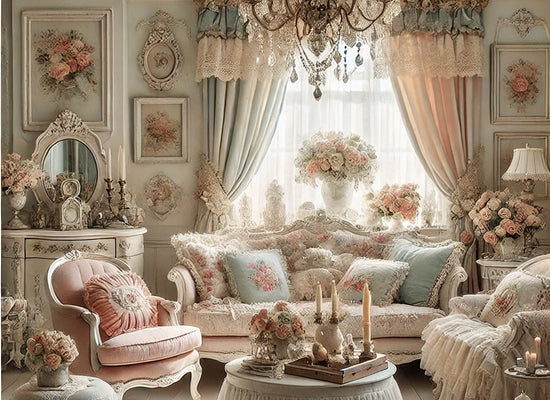
Description: Shabby Chic is a romantic, vintage-inspired style that became popular in the late 20th century. It emphasizes comfort, soft colors, and a worn-in, vintage look. Think of a charming cottage filled with flea-market finds that have been upcycled or distressed for character. Shabby chic spaces feel feminine, cozy, and nostalgic. Rather than polished and new, items are purposely a bit weathered, which gives the home a sense of history and charm as if it’s been lovingly lived-in for generations.
Notable Elements: White and pastel color schemes – lots of white, cream, blush pink, and robin’s egg blue, often all mixed for a layered tonal effect. Furniture is typically vintage or vintage-style, with distressed paint finishes (chipped white paint revealing wood underneath, for example). Floral patterns, especially roses, are common on fabrics or wallpaper. Soft, plush textiles like cotton slipcovers, lacy doilies, and ruffled throw pillows contribute to the softness. Decor includes an abundance of antique accessories: old picture frames, crystal chandeliers, wrought iron bed frames, and plenty of candles or fresh flowers. The overall vibe is delightfully cottagey and elegant in a casual way.
Southwestern Style
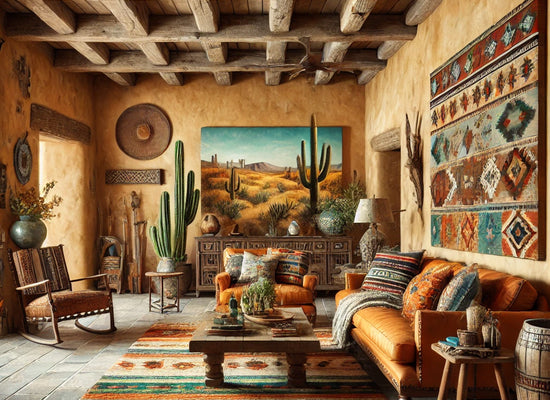
Description: Southwestern style draws inspiration from the American Southwest region (think Arizona, New Mexico) and also incorporates Native American and Spanish influences. It’s a style that reflects the desert landscape and indigenous craftsmanship. Interiors have a warm, earthy feel with a mix of ruggedness and vibrant artistic touches. A Southwestern space might remind you of a Santa Fe adobe home or a ranch in Sedona, blending comfort with bold cultural patterns.
Notable Elements: Earth-tone color palettes dominate – sandy beige, terracotta orange, cactus green, and turquoise (the gem so loved in Southwest jewelry) for pops of color. Walls are often textured plaster or adobe. Exposed wooden ceiling beams and saltillo tile floors or wide plank wood floors set a rustic tone. Furnishings may include leather sofas, handcrafted wooden pieces, and ironwork. Textile patterns are huge in this style: you’ll see Navajo or Aztec-inspired geometric designs on rugs, blankets (like iconic Pendleton wool throws), and pillows. Ceramics and pottery, woven baskets, and art featuring desert motifs or tribal patterns add authenticity. Don’t forget accents like cowhide rugs or antlers, which can appear in ranch-inspired Southwestern decor. The style feels warm, inviting, and connected to local heritage.
Traditional Style
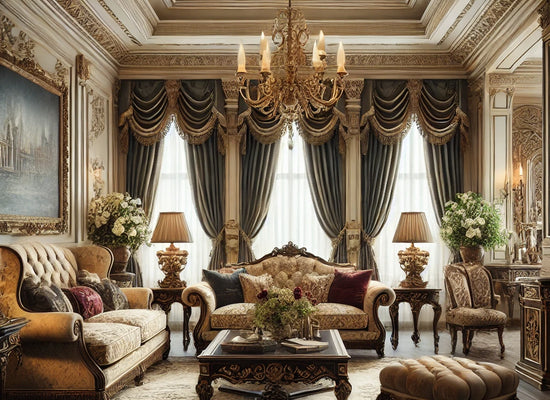
Description: Traditional style is rooted in classic European decor and the heritage of the past. It evokes the interiors of elegant homes from the 18th and 19th centuries (think Victorian parlors or Colonial-era homes), but it can be adapted to modern living. Traditional decor is known for its symmetry, rich color schemes, and attention to detail. Rooms often feel formal yet inviting, with a focus on comfort and familiarity. This style stands the test of time – it’s not about the latest trend, but rather creating a warm, refined atmosphere.
Notable Elements: Furniture with classic silhouettes – for example, wingback or rolled-arm chairs, dark wood dining tables with carved legs, and cabinetry with paneled doors. Upholstery and drapery in fabrics like damask, velvet, or silk; patterns such as florals, stripes, plaids are common. Decorative molding and trim (crown moldings, wainscoting) enhance the architecture. A mix of antique or reproduction pieces, such as a gilded mirror or a crystal chandelier, add elegance. Traditional color palettes often include warm neutrals (beige, cream, ivory) with deeper accent colors (burgundy, navy, hunter green).
Transitional Style
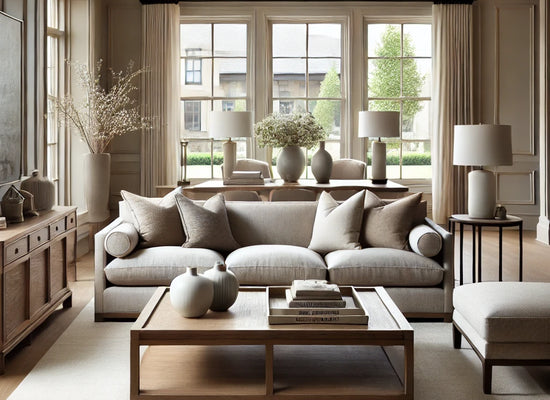
Description: Transitional style bridges the gap between traditional and modern. It’s a balanced mix of classic and contemporary elements, resulting in a comfortable, stylish home that isn’t too formal or too edgy. If you like some aspects of traditional design (like the warmth and welcoming feel) but also appreciate the clean simplicity of modern styles, transitional is a happy medium. The look is streamlined without being stark and rich without being fussy.
Notable Elements: A neutral color scheme is common – lots of soft grays, taupes, and creams – which creates a calm backdrop. You might see traditional furniture shapes in updated fabrics or finishes (for instance, a classic sofa shape upholstered in a simple, solid-colored linen). Wood tones are often lighter or distressed to be less formal. Accessories and decor are kept minimal and purposeful to avoid the clutter of purely traditional style, but not as bare as modern minimalism. Overall, transitional rooms feel tailored and harmonious, combining the best of old and new.
